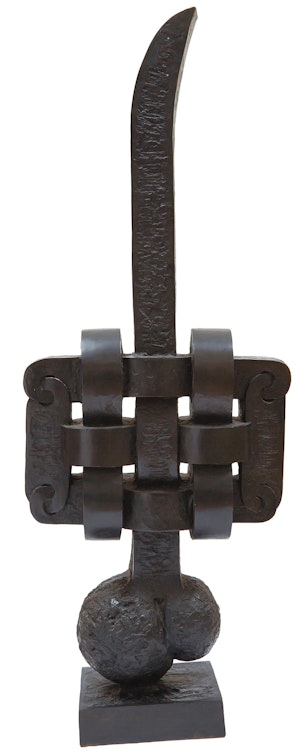Pulcinella II by Sorel Etrog

Sorel Etrog
Pulcinella II
bronze
stamped signature (twice) and numbered (1/7) on the base
44 x 16 x 7.5 ins ( 111.8 x 40.6 x 19.1 cms ) ( overall (including base) )
Auction Estimate: $20,000.00 - $30,000.00
Price Realized $21,600.00
Sale date: March 1st 2022
Benjamin Galleries, Chicago (1972)
Private Collection, Chicago
Private Collection, Ontario
Sir Philip Hendy, Preface to “Sorel Etrog”, Toronto, 1967, reprinted in “Sorel Etrog: Five Decades”, Toronto, 2013, page 93
Etrog was chosen to represent Canadian sculpture at the Venice Biennale in 1966. In his Preface to “Sorel Etrog”, Sir Philip Hendy, Director of the National Gallery in London, describes that “of the many spirits which live in [Etrog’s] bronzes, the most obvious perhaps is the spirit of metal itself...Etrog understands its substance, its tensions and its surfaces-above all, its tensions.” “Pulcinella II” is a large and powerful work, imbued with a tension of opposing forces. William Withrow characterizes these tensions as “linear and volumetric, geometric and organic, restful and dynamic, sensual and spiritual.”
The years surrounding “Pulcinella II’s” creation were particularly successful for Etrog. After immigrating to Canada, he had his first travelling exhibition in 1965. The show began at Gallery Moos, then travelled to New York City, Los Angeles, and Montreal. In 1966, Etrog, alongside Yves Gaucher and Alex Colville, represented Canada at the Venice Biennale. He later received several important commissions, including those for Expo ’67, the SunLife Centre in Toronto, and the Windsor Sculpture Garden.
While works from this series have been exhibited as “Pulcinella” and “Pulcinella I”, the estate of the artist records the bronze as “Pulcinella II”.
Share this item with your friends
Sorel Etrog
(1933 - 2014) RCA
Based in Toronto for more than fifty years, Sorel Etrog was born in Iasi, Romania, in 1933. He is most well-known as a sculptor, but he also illustrated books, painted, and wrote poetry, plays, and films. His sculptures were influenced by his adolescence spent under Soviet rule and an interest in philosophical writings that questioned the nature of post-war society. He was also inspired by his grandfather who was a carpenter. Etrog, along with his parents and sister attempted to flee Romania in 1946 but were caught. His parents were then imprisoned for several weeks. Finally, Etrog and his family left Romania in 1950 and made it to the Sha’ar Aliyaa refugee camp near Haifa, Israel.
While serving mandatory time in the Israel Defense Forces’ medical corps in 1953 he began studying art at Tel Aviv’s Arts Institute for Painting and Sculpture. Inspired by Cubist collage and modernist music, he created three-dimensional paintings, mimicking constructivist reliefs. In 1958, he received a scholarship to attend school at the Brooklyn Museum of Art School.
Upon arrival in New York City, Etrog became drawn to African and Oceanic art due to their expressive shapes and began incorporating these elements into his work. While trying to find gallery representation in New York City, Samuel J. Zachs purchased one of Etrog’s paintings and invited Etrog to spend the summer of 1959 in Southampton on Lake Huron with him. While in Southampton, Etrog created his first wooden sculptures and gained gallery representation from Gallery Moos in Toronto. This encounter inspired the young artist to apply for Canadian citizenship and eventually move to Toronto in 1963.
In his mature sculptural works, Etrog explores spontaneous symbols, primal elements and the relationship between form and symbol. The artist described his art as "tension created by pulling together and pulling apart, with being stuck and being freed, a world of grabbing and holding on and losing hold...bringing shapes together but at the same time giving each an independence."
After immigrating to Canada, Etrog had his first traveling exhibition in 1965. The show began at Gallery Moos, then traveled to New York City, Los Angeles, and Montreal. In 1966, Etrog, alongside Yves Gaucher and Alex Colville, represented Canada at the Venice Biennale. He later received several important commissions, including those for Expo ’67, Montreal; SunLife Centre, Toronto; Windsor Sculpture Garden, Windsor, Ontario; Los Angeles County Museum, and Olympic Park in Seoul, Korea. Before his death in 2014, Etrog’s art was included in a retrospective at Buschlen Mowatt in Vancouver in 2003.
Literature Sources:
"A Dictionary of Canadian Artists, Volume I: A-F", compiled by Colin S. MacDonald, Canadian Paperbacks Publishing Ltd, Ottawa, 1977
Mikulinsky, Alma, “Sorel Etrog: Life and Work,” Toronto: Art Canada Institute, 2018
We extend our thanks to Danie Klein, York University graduate student in art history, for writing and contributing this artist biography.

